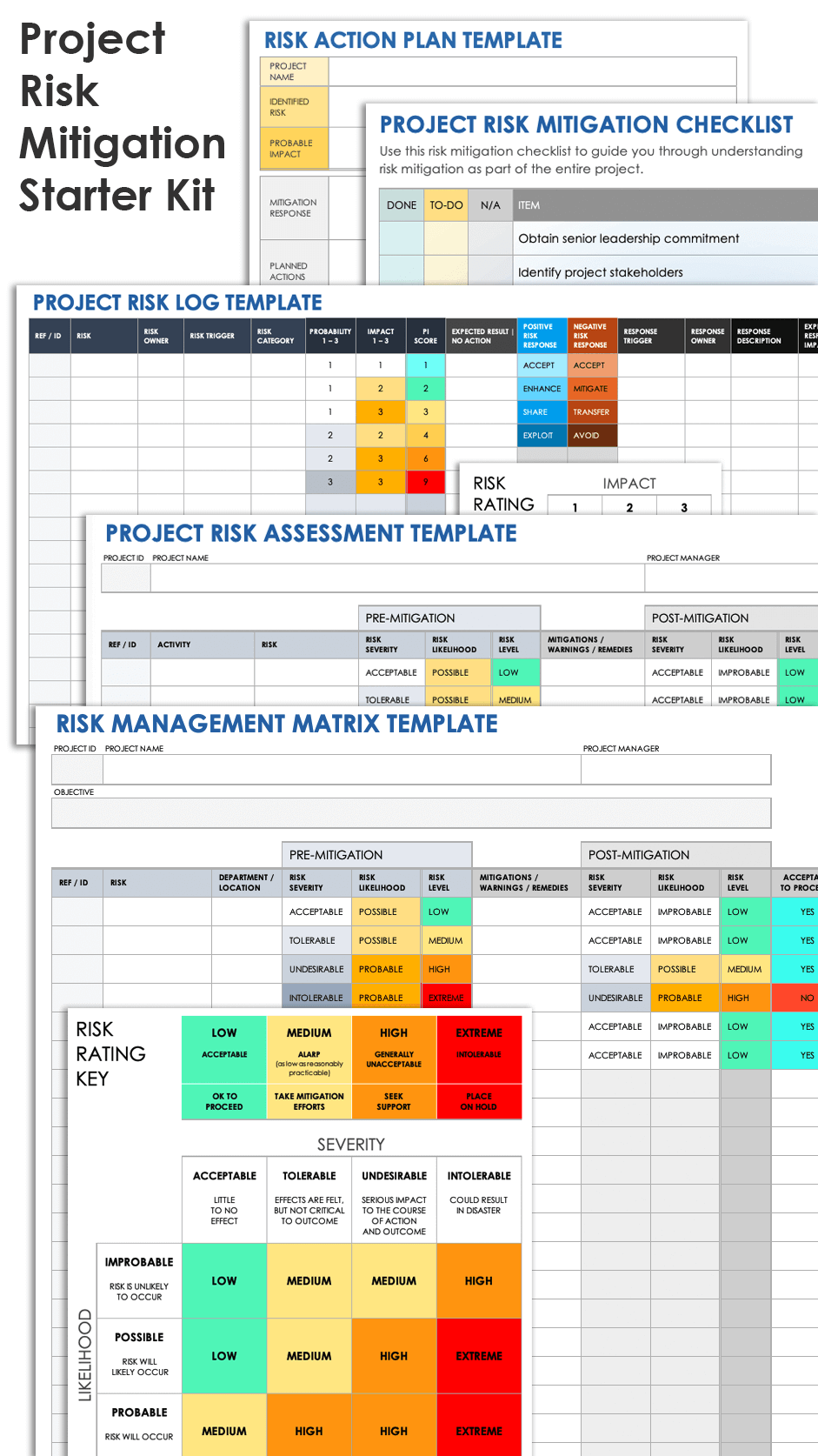What Is Project Risk Mitigation?
Project risk mitigation is a strategic plan to lessen the impact or likelihood of negative risk events. On a team, the project manager is responsible for overseeing the risk mitigation process. Risk mitigation addresses threats to project delivery and continuity.
Why Is It Important to Mitigate Risks in Project Management?
Project managers mitigate risks so that risk events do not derail projects. Risks can impact the cost, scope, or schedule of a project. The risk mitigation process prepares project managers to manage uncertainty.
New, innovative products and services are key to growth and improvement, but with new innovation comes risk. Ignoring project risks, or hoping they do not occur, is ineffective. Project managers need to manage risk as part of their project planning process. According to writers at McKinsey, the absence of risk mitigation leaves companies open to “serious risk events that can be crippling.”
“Risks can lead to an overage in your approved budget, delays in your project timeline, or missed expectations,” shares Amy Black, Director of Security, Privacy, and Risk at RSM US LLP. “Even more, unmitigated issues may lead to project failure altogether. It is important to mitigate risks to avoid any of these unfortunate outcomes. Identifying risks as early in the project timeline as possible gives the project manager a chance to course correct before a risk comes to fruition.”
The success of a project depends on whether or not project managers can either prevent or mitigate the impact of adverse risks. Alexis Nicole White, a senior project management consultant with North Highland, stresses that when project costs increase, the quality of a product suffers. “It is very likely that the product quality begins to suffer when, due to budget, the project schedule is compressed into a tighter delivery period or resources must work longer hours to complete the project sooner.”
In his comprehensive study, “Risk Mitigation Strategies in Innovative Projects,” Riaz Ahmed explains that incorporating risk mitigation can bring about the following benefits:
- Faster Project Completion: Risk mitigation actions reduce overall project risk, thus accelerating project completion.
- More Predictable Schedules: Project managers who enforce risk mitigation strategies experience fewer surprises and therefore have more predictable project schedules.
- Reduce Project Costs: When teams are able to complete projects on or ahead of schedule, it reduces the project’s cost.
- Produce a Historical Audit Record: Risk mitigation provides an audit record of risk handling effort in a project that may provide useful insight for future projects.
- Maximize Shareholder Value: By reducing unanticipated costs and increasing the success rate of projects, risk mitigation helps maximize shareholder value.
How Do You Mitigate Risk on a Project?
In order to mitigate project risk, follow a standard risk mitigation process. This involves identifying risks and implementing a strategy for each risk. By doing so, you can minimize the chances of project disruption.
These are the two steps of any risk mitigation process:
- Identify the potential risk.
- Implement a strategy that will remove or lessen the impact of each risk.
As you work through the risk identification and mitigation processes, keep lines of communication open. “Regular, open dialogue with your project team and stakeholders helps project managers identify unanticipated risks,” says Black. “Prompting your team with open-ended questions to encourage upfront and honest conversations allows the team to work together on risk mitigation strategies that account for all possibilities.”
Types of Project Risk Mitigation Processes
Any risk mitigation process or strategy will help reduce risks to a project. Some strategies include avoiding, assuming, controlling, or transferring risks. A risk mitigation plan involves measuring the impact of the risk and preparing a response strategy.
The following types of risk mitigation processes and strategies may be helpful as you assess, plan for, manage, and monitor your project risks:
- Avoid the Risk: Avoiding the risk involves taking action to resolve or eliminate the threat. For example, if there is a risk that scheduling conflicts might delay delivery, the team can create a comprehensive calendar to prevent these conflicts.
- Accept or Assume the Risk: If the consequences of the risk are not dire, the team may choose to acknowledge, but not act on, the risk. For example, if there is a chance a project will be slightly over budget, an acceptance strategy might be to assess and acknowledge the consequences of going over budget.
- Reduce, Mitigate, or Control the Risk: The goal of reducing risk is to accept the identified risk and apply measures to minimize its impact. For example, if the building materials required to start construction are arriving from multiple vendors, the risk that certain materials will be delayed is out of the project manager’s control and can’t be eliminated. However, the project manager can reduce the risk by setting deadlines, following up with vendors on shipment status, and sourcing as many materials as possible from local vendors.
- Transfer the Risk: Assigning the risk to a third party mitigates the consequences of risk by placing responsibility on a third party. For example, transferring product security protocols to a cyber security provider removes the burden and the necessity for specialized expertise. This allows the project team to focus on their assignments while leaving one issue to a third party.
Risk mitigation techniques can increase project complexity and costs. However, expending resources on risk management can have benefits in the long run. In his study for OCLC, H. Frank Cervone concludes, “it is easier and less costly to avoid risk in the first place, rather than attempting to fix or remediate problems once they have occurred. Not surprisingly then, when good project managers think about risk management, they focus on mitigating risk within the overall project.”
Applying a risk mitigation strategy to each risk may help proactively address risk events. Alan Zucker, Founding Principal at Project Management Essentials, says, "Reducing, mitigating, or controlling the risk may be the most commonly used response strategy because avoiding the risk or transferring it to another party may not be feasible.”
Zucker shares an example of failed risk mitigation from his experience with software project management. “A new software application project required a new server to run in production,” he says. “The team knew this. However, the team did a bad job mitigating the project risk, and the project was delayed because a server was not purchased and configured in time. This was a relatively easy risk to manage. The risk statement would have been: if a new server is not purchased and configured by the release date, then the release may be delayed. The impact of this risk would have been high. Initially, the likelihood would have been low because there was plenty of time to address the threat, but as the project progressed, the likelihood of the risk impacting the release increased.”
Zucker proposes these risk mitigation strategies that the team could employ to reduce the impact of the risk on this project:
- Accept the Risk: “Establish time-based triggers so that at various points in the project, the lack of progress on procuring and configuring the new server will escalate,” he says.
- Reduce the Risk: “Reconfiguring existing lower environments to production or hosting the application with another could reduce the likelihood and impact of not having a new server,” explains Zucker.
- Transfer the Risk: “Move the application to the cloud,” he suggests. “The risk of running the app would then be on the service provider.”
Project Risk Mitigation Starter Kit
Get everything you need for mitigating project risk with this free, downloadable project risk mitigation starter kit. The kit includes a risk mitigation checklist, risk matrix and assessment templates, a risk action plan, and a project risk log in one easy-to-download file.
Download the Project Risk Mitigation Starter Kit
In this kit, you’ll find the following:
- A project risk mitigation checklist in Microsoft Word , Google Docs, and Adobe PDF formats to help you account for every step in the risk mitigation process.
- A project risk mitigation management matrix template for Excel to help you track and analyze risks and assign risk mitigation strategies in one, centralized location.
- A risk action plan template for Excel to help you track details of your mitigation plan.
- A project risk assessment and analysis template for Excel to document risk levels and mitigation details.
- A project risk log template for Excel to track and manage important risks and assign them owners and mitigation plans.
Example of Project Risk Mitigation for a Construction Project
Each industry vertical has unique risks. Construction risks result from poor resource management, scheduling errors, policy failures, and unclear project duties. The construction project manager will define a mitigation strategy for each risk or hazard.
For example, due to disruptions in the global supply chain, shipment schedules are always in flux. If there is a supply chain disruption during a construction project, shipping delays might result in costly penalties for late project completion.
These are some actions a construction project manager might take to mitigate this risk:
- Avoid: Take an action that will eliminate the risk. For example, choose to source all materials from local providers, who are not impacted by global supply chain disruptions.
- Transfer: Transfer risk to another party. For example, hire a subcontractor to source building materials so that they assume the risk of penalties for delayed construction.
- Reduce: Reduce the likelihood of the risk or its impact. Mitigate by maintaining a supplies warehouse or increasing contract prices to account for change.
- Accept: Accept the risk and create a backup plan by preparing customers for potential price increases and delays.
Example of Project Risk Mitigation for an IT Project
The IT Infrastructure Library (ITIL) is a service management framework for IT providers. ITIL risk management best practices and guides risk prioritization for the IT services lifecycle. These risk mitigation strategies include avoiding, reducing, sharing, and accepting risk.
A major risk to many IT projects is a lack of specialized knowledge. If a team member who can perform a specific IT function is not available, it could delay or derail a project.
Using ITIL guidelines, these are some strategies a project manager might use to mitigate risk for this project:
- Risk Avoidance: Prevent the risk by not performing the risky activity. For example, if there is not a team member available who has specialized knowledge of C++, then a project manager might choose to rework the project so that knowledge is not necessary.
- Risk Modification or Reduction: Implement controls to reduce the likelihood or impact of the risk. For example, a team leader might choose to train an existing employee on the specialized skill so that they can perform those tasks for the project.
- Risk Sharing: Reduce the impact by passing some risk to a third party. For example, a project manager might hire a contractor to complete a portion of the project that internal team members are not able to complete.
- Risk Retention or Acceptance: The decision to accept the risk because it’s below an acceptable threshold. For example, a manager might proceed with a project because the time conflict with a very low priority project may impact scheduling.
Black shares how project risk mitigation strategies contribute to successful project implementation at her work. “We are implementing a new project management software that will replace an existing application and be utilized by thousands of consulting professionals,” she says. “The project team formed end-user subcommittees that are responsible for application user testing, business case development, and training for all users. During the initial business case development, the subcommittee identified users using the previous applications in vastly different ways. This created a potential issue as the new software wasn’t originally intended to meet all documented expectations.
“The subcommittees were able to identify and document the business cases early,” she continues. “While the mitigation strategies still delayed the originally planned timeline, the project manager could adequately document all use-case scenarios and work with key stakeholders and leadership to reassess the budget to produce a quality deliverable that met everyone’s expectations. This ultimately led to greater acceptance of the new software and smoother implementation.”
Project Risk Mitigation Best Practices
Following project risk mitigation best practices helps ensure that you minimize the impact of negative risks on your projects. Some best practices include staying transparent, documenting risks, monitoring risks continuously, and starting risk mitigation early.
The best project risk mitigation practices help the project manager manage uncertainty. Here are some best practices to help ensure that your project risk mitigation is successful:
- Clear Communication: “Throughout every project touchpoint and status update, I always review the status of the project’s risks first. For example, if the risk is inclement weather, I’d say, ‘Weather – accepting.’ We are still accepting the risk of inclement weather by reviewing the weather daily and ensuring all resources are properly informed about the plan of action should severe weather storms appear,” shares White.
- Transparency: “A best practice for mitigating risks is to ensure you have a viable Risk Issue Action and Decision (RAID) log updated and transparently available for all team members to review at any time. Additionally, review these items with your team before each meeting,” says White. “Do not just document said items and keep them in your possessions. Document them and be transparent about the team’s concerns. As project managers, we’re supposed to confront and address any issues that may compromise the integrity of the project, which means managing risks appropriately.”
- Risk Documentation: “Document your project risks often. Even if the risk never materializes, documenting it keeps it at the forefront of the team’s minds and can help avoid any additional risks or unwanted changes,” advises Black.
- Continuous Monitoring: Risk mitigation is not something that a team does once. Teams need to continually identify and analyze vulnerabilities and threats so that risk mitigation measures can be taken before they impact the project.
- Policy Documentation: Be sure to clearly document your risk mitigation process, strategies, and roles, and ensure that they are easily findable and accessible for the team and stakeholders.
- Early Risk Mitigation: Risk mitigation requires early intervention. Preparing for potential risks and taking action early in the project can help minimize disruption.
Take Control of Project Risks with Real-Time Work Management in Smartsheet
Empower your people to go above and beyond with a flexible platform designed to match the needs of your team — and adapt as those needs change.
The Smartsheet platform makes it easy to plan, capture, manage, and report on work from anywhere, helping your team be more effective and get more done. Report on key metrics and get real-time visibility into work as it happens with roll-up reports, dashboards, and automated workflows built to keep your team connected and informed.
When teams have clarity into the work getting done, there’s no telling how much more they can accomplish in the same amount of time. Try Smartsheet for free, today.



